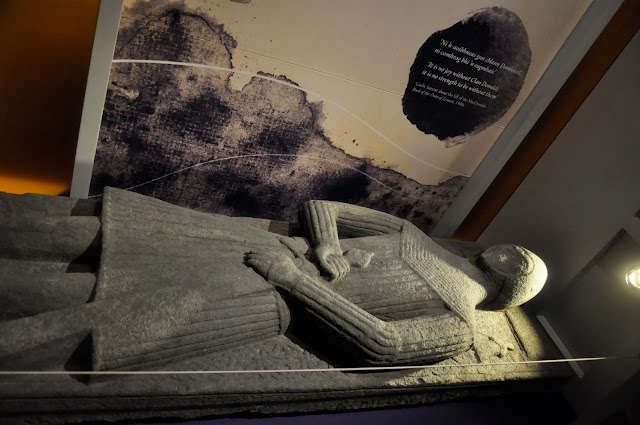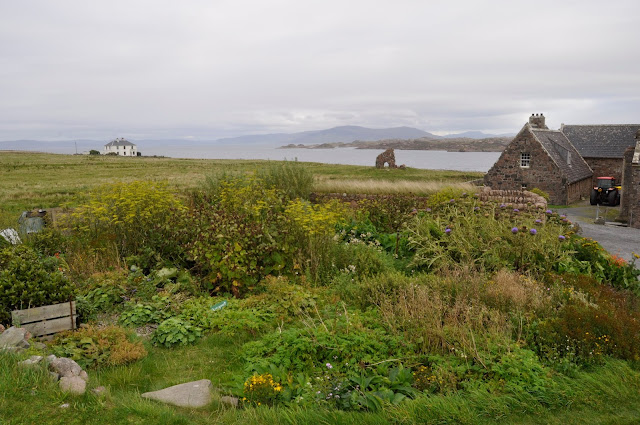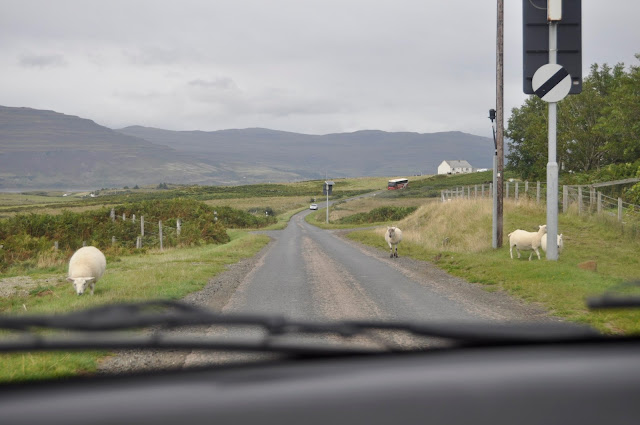I cast a couple of spells to conjure up better weather for us for our trip to the Isle of Iona.
They work.
We travel to the bottom of Mull where the village of Fionnphort lies
with its outcroppings that originated long, long ago when the world looked very different.
These rocks were laid down when Greenland and Scotland violently and volcanically
separated from the larger continent that once existed - this parting of the ways
created the North Atlantic Sea.
We can still see the results today in the different forms of rocks
that make up Mull and Ion - these are processes that are truly written in stone.
Here is an engaging, comprehensive article by David Stephenson that describes
some of the processes involved, called
Here is Andrew's very own bus in the Fionnphort parking lot, but he's not on it.
We miss him!
The last time we were in Scotland, he was with us, back in May, 2001.
Here's a picture we took in a London photo booth, marking our presence in the British Isles.
Maybe when Andrew and Jennifer's son gets a little older (after he's born in November)
they'll be able to join us!
Meanwhile, Aaron and I trek on.
This photo was taken by a kind stranger
as we wandered through Fionnphort's sandy terrain...
...peering at sand patterns and strange seaweeds
that snap like nature's bubble wrap when you walk on them.
that snap like nature's bubble wrap when you walk on them.
Fun fact: Fionnphort got its first ATM machine in 2008 so the eighty residents didn't have to
travel 100 miles round trip to get cash.
According to Wikipedia,
they brag that their "cash dispenser" has the best view in the British Isles.
The ferry to Iona takes a mere ten minutes.
I try to take pictures on the way, but swarms of tourists get in my way.
First things first - right off the ferry we go to the Argyll Hotel and have lunch.
While there, I peruse their shelf of books and find this old one
that seems to have a Latin title.
Which roughly translates into "Enjoy life, or, let us rejoice while we are young."
(Later, Frank immediately recognizes this phrase and sings it out grandly - apparently
this is what school boys sing when they graduate.)
But inside, there seem to be what is described in a small label
as German folk songs. Go figure!
These is what's left of our lunch after we eat our fill, thick bread spread with an inch of butter,
and chopped eggs swimming in mayo. We take the remains for later.
Good thing we're doing a lot of hiking.
Aaron orders a Fentiman's Curiosity Cola, which is supposed to taste like the colas of yore.
But not with the cocaine that the original Coca-Cola was named for.)
I'm not a cola fan, but this one is pretty good.
A refreshing gingery taste. I hope they don't sell it in New York,
or I might be forced to drink it often.
After lunch, we visit the ruins of an old nunnery, now an airy green place.
The island has been Christian since the sixth century when St. Columba, an Irish monk,
built the first abbey, helping to destroy the ancient Druidic traditions among the pagan Picts.
(You may not realize, as I did not, that kissing under mistletoe is an adaptation of Druidic fertility rites.) Columba left Ireland after a violent battle over who had rights to a manuscript
that he had copied at the scriptorium,
and other mysterious issues involving rights of sanctuary, hurling matches and murdered princes.
These are the skeletons of a groined arch in one of the passageways.
Aaron tries his hand at being a monk, but doesn't do well.
Next we stop by the Abbey that has been restored in the twentieth century
to some (actually a great deal) of its former grandeur.
Lots of awesome local stone is evident in its walls, which makes me smile.
Aaron looks like an Oxford scholar striding along purposefully to his next scholarly activity.
Inside the Abbey museum,
we see a Celtic cross that has been bolstered by modern materials.
I find this mix of old and new appealing in a kind of "truth to materials" way.
We also see the tombs, or "grave slabs" of unknown soldiers,
mercenaries from a seriously rough time when men slung around battle axes and swords,
a very hands-on kind of fighting, some of whom ended their struggles in Iona
and were buried with honors.
The illustration makes him look more manly and substantial than does the grave slab,
whose stiffness reminds me a bit of Data in the Star Trek series.
Now here is a fierce sight - this fellow seems to be staring us down
from a deep, dark past.
from a deep, dark past.
But there are hills to climb, we must onward go!
On our way we see some shmoozing cattle.
I believe the one on the left is a bull, but it's rare to see a bull running free
in a pasture, as they are known for not letting something like a mere wire fence
get in their way when a far off whiff of cow-lady pheromones wafts over the moors.
So maybe it's a steer (aka a castrated male bovid, for those of you non-farmers) - in any case,
I didn't look closely to check on the state of his equipment.
It seems that as we get closer, the hill gets bigger.
I huff and puff a bit, but Aaron breezes upwards
to be where the birds fly.
We see an enigmatic beehive structure
that is unexplained.
Aaron contemplates its meaning.
Then he checks his connectivity.
Those specks that look like insects are actually proverbial black sheep grazing far, far below.
The view is spectacular from all sides.
Oh, no! A fierce Scottish wolf!
Just kidding, it's someone's dog.
Aaron discovers a deep pond in a crevice.
No doubt a place of serious magic.
Or maybe where the shepherds of yore took the odd dip.
The view, the view!
Many, if not most of the houses are blindingly white.
We figure it's some kind of special paint-sealant that keeps the rocks
from continually weeping, which would create
a bit of a damp lifestyle.
Here's a mix of sheep-styles. Black, brown and white.
Bathtubs of all sorts are used for pasture drinking.
Clever, really. When I was farming we used metal tanks that could
split at the seams and leak. As long as the plug stays in, tubs are good to go.
Wouldn't like to bathe in these tubs, however.
Then we wander over the one of the many beautiful Iona beaches...
...where Aaron gets as high as he can.
Too bad we don't have our suits!
On the way back to the town, we see a pristine white mushroom growing from a cow pattie!
Bet it's delicious.
But we leave it to grow and prosper, and trek on through the sheep pasture.
Later I peruse the UK's National Sheep Association website to find
out what kind of sheep these are, and find them at the very end of the alphabet,
the Zwartble! Then again, maybe they're Balwen Welsh Mountain sheep.
I can't decide.
I can't decide.
This one proudly poses for us, showing off its trim shape and rich bronzy color.
Are black sheep really brown?
Are black sheep really brown?
There are a kazillion kinds of sheep, I learn from the NSA website.
Some of them very odd-looking...
...like the Texel, above,
the Oxford Down, below,
and the Jacob, which looks like a Holstein cow-sheep!
These three pics from the http://www.nationalsheep.org.uk/sheep-breeds.php
and http://www.oxforddownsheep.org.uk/description.htm
There's even one called the "Easy Care" sheep, which sounds ominously corporate-farming-ish,
as in this breed replace every other breed of sheep because they're so great,
reducing the breed stock and making them all vulnerable to an illness that could wipe them all out.
(Like bananas, which are all clones of each other, and what kills one will kill them all.)
But, according to http://www.easycaresheep.com/, they
“...require minimal treatment for fly strike and are far less likely to become stuck on their backs and there is no need to tail dock lambs either.”
If you watch the center area of this video, you will see a sheep on its back, flailing around
and it seems, yes, to be struggling to get back on its feet.
Who knew that this was a sheep-ish issue!
A couple of lovely Iona-ian houses and yards.
We revisit the Abbey, where the local-stoniness is even more awesome from the inside.
Here are two royals resting forever peacefully.
The abbey courtyard
hosts a sculpture that appears very strange to me at first, with the Madonna
figure looking kind of oddly hollowed-out from face to waistline...
...until I realize that it's a twentieth century
piece, where strange, stranger and strangest was the norm,
this one by Jacques Lipschitz with his signature kind of lumpy-cubism,
like his "Government of the People" in Philadelphia.
Really, I prefer the Celtic interlaces,
the ancient worn stone that shows traces
of past minds reaching toward the spirit part of us,
using an abstract language, intertwining pathways developed over many centuries,
ripe with graceful symbolism and meaning.
Unlike the emptied-out Madonna figure that reaches blindly outward while a bird pecks at her head.
Ah, here's a resident of Iona that I would sooner avoid.
Alas, it's time to leave the azure waters of Iona...
...and ferry back to Mull.
In Fionnphort again, we note the split rock.
I find out later it is an "erratic" laid down by a receding glacier in the misty past.
We wish we had time to visit Pottie, but we must keep moving ahead...
...past road sheep...
...and more road sheep...
...as Aaron once again successfully handles the complexities of Mull single-lane, left-hand driving.






























































No comments:
Post a Comment